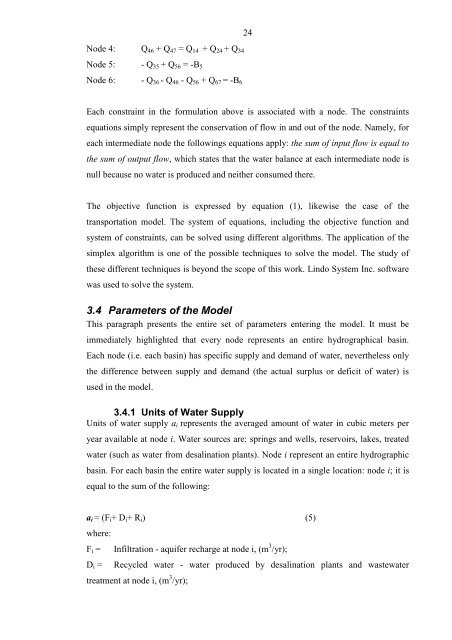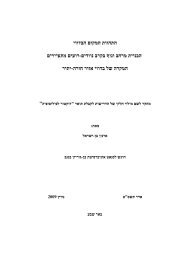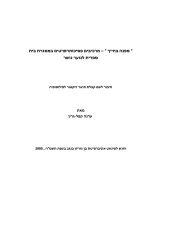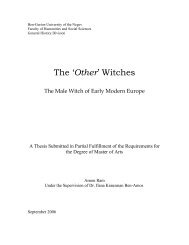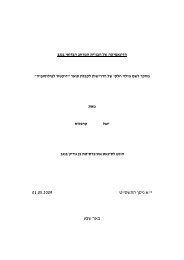Ben-Gurion University of the Negev Jacob Blaustein Institutes for ...
Ben-Gurion University of the Negev Jacob Blaustein Institutes for ...
Ben-Gurion University of the Negev Jacob Blaustein Institutes for ...
You also want an ePaper? Increase the reach of your titles
YUMPU automatically turns print PDFs into web optimized ePapers that Google loves.
Node 4: Q46 + Q47 = Q14 + Q24 + Q34<br />
Node 5: - Q35 + Q56 = -B5<br />
Node 6: - Q36 - Q46 - Q56 + Q67 = -B6<br />
24<br />
Each constraint in <strong>the</strong> <strong>for</strong>mulation above is associated with a node. The constraints<br />
equations simply represent <strong>the</strong> conservation <strong>of</strong> flow in and out <strong>of</strong> <strong>the</strong> node. Namely, <strong>for</strong><br />
each intermediate node <strong>the</strong> followings equations apply: <strong>the</strong> sum <strong>of</strong> input flow is equal to<br />
<strong>the</strong> sum <strong>of</strong> output flow, which states that <strong>the</strong> water balance at each intermediate node is<br />
null because no water is produced and nei<strong>the</strong>r consumed <strong>the</strong>re.<br />
The objective function is expressed by equation (1), likewise <strong>the</strong> case <strong>of</strong> <strong>the</strong><br />
transportation model. The system <strong>of</strong> equations, including <strong>the</strong> objective function and<br />
system <strong>of</strong> constraints, can be solved using different algorithms. The application <strong>of</strong> <strong>the</strong><br />
simplex algorithm is one <strong>of</strong> <strong>the</strong> possible techniques to solve <strong>the</strong> model. The study <strong>of</strong><br />
<strong>the</strong>se different techniques is beyond <strong>the</strong> scope <strong>of</strong> this work. Lindo System Inc. s<strong>of</strong>tware<br />
was used to solve <strong>the</strong> system.<br />
3.4 Parameters <strong>of</strong> <strong>the</strong> Model<br />
This paragraph presents <strong>the</strong> entire set <strong>of</strong> parameters entering <strong>the</strong> model. It must be<br />
immediately highlighted that every node represents an entire hydrographical basin.<br />
Each node (i.e. each basin) has specific supply and demand <strong>of</strong> water, never<strong>the</strong>less only<br />
<strong>the</strong> difference between supply and demand (<strong>the</strong> actual surplus or deficit <strong>of</strong> water) is<br />
used in <strong>the</strong> model.<br />
3.4.1 Units <strong>of</strong> Water Supply<br />
Units <strong>of</strong> water supply ai represents <strong>the</strong> averaged amount <strong>of</strong> water in cubic meters per<br />
year available at node i. Water sources are: springs and wells, reservoirs, lakes, treated<br />
water (such as water from desalination plants). Node i represent an entire hydrographic<br />
basin. For each basin <strong>the</strong> entire water supply is located in a single location: node i; it is<br />
equal to <strong>the</strong> sum <strong>of</strong> <strong>the</strong> following:<br />
ai = (Fi+ Di+ Ri) (5)<br />
where:<br />
Fi = Infiltration - aquifer recharge at node i, (m 3 /yr);<br />
Di = Recycled water - water produced by desalination plants and wastewater<br />
treatment at node i, (m 3 /yr);


